5 Best Colored Pencils of 2025 (Blending, Lightfastness, Vibrancy)
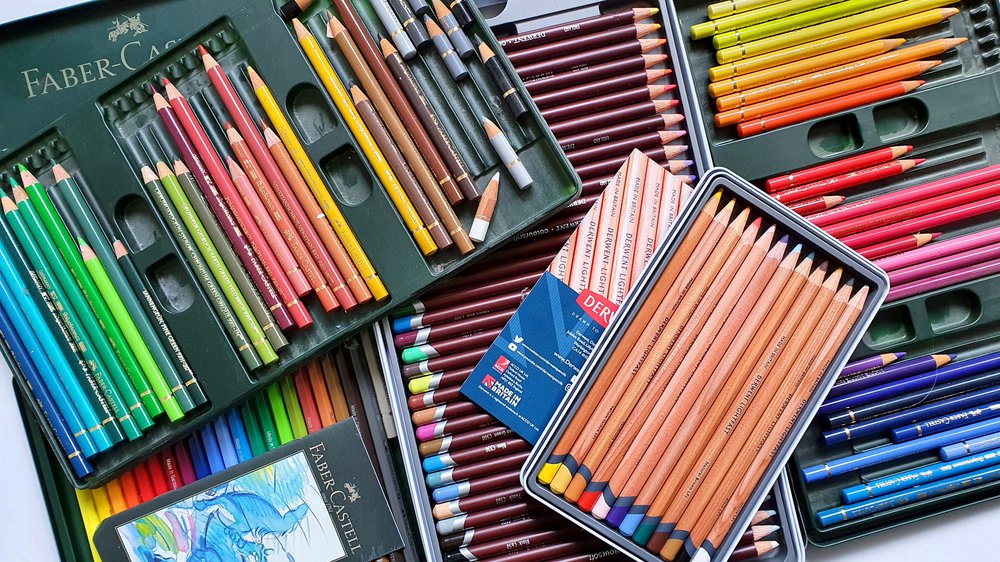
As a seasoned artist, I've had the chance to experiment with a wide range of colored pencils over the years. I know how essential it is to have the right tools to create vibrant, detailed, and long-lasting artwork. And today, I'll share my top five picks for the best colored pencils on the market.
Disclaimer: In the name of full transparency, please be aware that this blog post contains affiliate links and any purchases made through such links will result in a small commission for me (at no extra cost for you).
What are the best colored pencils?
Good pencils can make a huge difference in the outcome. The transitions will look better. The colors will look vibrant and pigmented. And sharpening won't be a pain anymore. So here's a list of the best colored pencils that make the drawing process a lot more enjoyable.
1. Caran d'Ache Luminance 6901
Highest quality and lightfastness, and best blending

In my opinion, Caran d'Ache Luminance colored pencils are the cream of the crop. These Swiss-made, wax-based pencils are known for their exceptional quality, blending, and superb lightfastness. The majority of the Luminance pencils have an LFI rating, meaning they'll resist fading for over 100 years. This is a must for any artist who wants their work to stand the test of time.
The Luminance colored pencils are incredibly creamy and blendable, thanks to their high pigment concentration and soft and creamy wax-based lead. These pencils glide smoothly on paper, making it a breeze to create detailed, richly colored artwork.
The only downside? They're on the pricier side. But I believe that the superior quality and longevity of these pencils make the investment well worth it.
2. Derwent Lightfast
Best balance for drawing details and blending, while remaining very lightfast

Next up, we have the Derwent Lightfast colored pencils. Made in the UK, these pencils are specifically designed to be lightfast, ensuring that your artwork remains vibrant and resistant to fading. Derwent claims that these pencils are 100% lightfast under museum conditions, and the majority of their pencils have an impressive LFI or LFII rating.
One key feature of the Derwent Lightfast pencils is their oil-based core. Unlike other oil-based pencils, Derwent has managed to create a soft and creamy lead that still allows for precision and detailed work. These pencils also boast high pigmentation and saturation, making your colors pop.
The thick cedar wood barrel ensures easy sharpening and added protection for the lead. The Derwent Lightfast colored pencils come in a range of 100 colors, offering a diverse palette to choose from.
3. Faber-Castell Polychromos
Best for drawing details and vibrancy
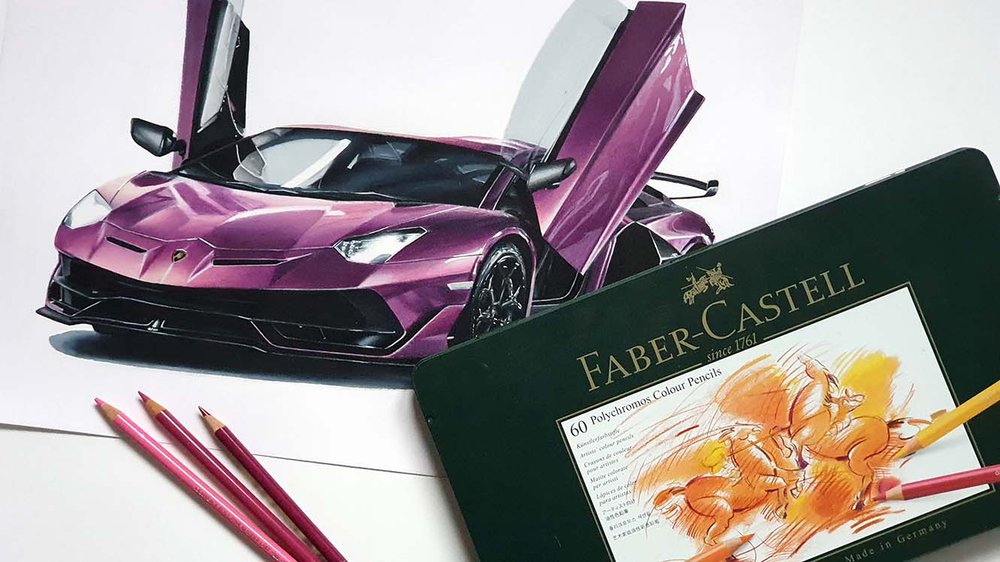
If you're all about vibrancy, Faber-Castell Polychromos colored pencils are the ones for you. These German-made pencils are renowned for their intense pigmentation, giving your artwork that extra wow factor.
Polychromos pencils are oil-based, with a harder core that's perfect for detailed work. You can sharpen them to a fine point for those intricate details, but be careful as the lead can be a bit fragile. Just be gentle when sharpening and avoid dropping them to prevent breakage.
Though oil-based pencils can be more challenging to blend, with the right techniques, you can achieve smooth color transitions with Polychromos. These pencils are also highly lightfast, ensuring your artwork's longevity.
With a color range of 120 shades, you'll have plenty of options to choose from, although the skin tones and purples could be more diverse.
4. Derwent Chromaflow
Best blending for a tighter budget
For those who prioritize blending but find Caran d'Ache Luminance a bit expensive, Derwent Chromaflow colored pencils are a fantastic alternative. These wax-based pencils have a soft core that's easy to blend and strong enough to resist breakage when sharpening and drawing.
While Derwent claims that these pencils meet high standards, their lightfastness isn't explicitly mentioned on their website. However, they do state that Chromaflow pencils have comparable lightfastness to other products within the same price range.
With a color range of 72 shades, Derwent Chromaflow offers a decent selection of colors for your artwork. The only downside is the limited number of skin tones in the set.
The Chromaflow pencils feature a harder wood barrel, making them slightly more challenging to sharpen. However, the black barrel design with colored ends and gold lettering gives these pencils an exclusive, luxurious appearance.
5. Prismacolor Premier
Best option for beginners
Last but not least, we have the Prismacolor Premier colored pencils. These are the most budget-friendly option among the top five, making them an excellent choice for beginners or those who don't plan on selling their artwork.
Prismacolor Premier pencils are wax-based, resulting in a soft and creamy texture that's perfect for blending. However, this softness means they're not as ideal for detailed work, as the point tends to wear down quickly.
While these pencils offer a wide range of 150 colors, they are not as pigmented and saturated as other brands, and their lightfastness is generally lower. Some colors have LFI ratings, but most fall within the LFIII to LFV range. Additionally, these pencils are prone to wax bloom, which can be remedied by gently wiping the drawing's surface.
The build quality of Prismacolor Premier pencils is not as high as the other options on this list. The narrow barrel and core make them more susceptible to breakage when sharpening or if accidentally dropped. However, their affordability and ease of blending make them a popular choice for artists new to colored pencils or for practicing techniques.
How I Tested the Colored Pencils
By testing each set of colored pencils thoroughly, I can form better conclusions about how well each set performs in real-world applications and not just manufacturer claims. This helps me provide the best and most valuable advice on which set is the best to buy.
What Are the Test Criteria?
- Pigmentation & opacity
- Blendability
- Smoothness of the core
- Ability to layer
- Ability to burnish
- Durability
- Quality
- Affordability
1. Pigmentation & Opacity
When you're looking to buy colored pencils, the richness of the pigment and opacity are important criteria.
If the pencils are not pigmented you can't create beautiful vibrant colors and they will look very transparent. This will make it difficult or even impossible to create bold and realistic drawings.
And if the pigment is very transparent you can also get a grainy finish no matter how gradual you layer.
If the core is very pigmented, however, the colors will look bright and vibrant and they are pretty opaque most of the time. This gives you way more control over how you want the colors to look and behave, making the coloring process more enjoyable.
I tested this by swatching the colors on a piece of paper and determining if they look opaque and vibrant or not.
2. Blendability
Blending is a technique I (& many other artists) use all the time when coloring with colored pencils.
When creating realistic drawings of portraits, clouds, cars, etc, you need to be able to create soft and smooth color gradients by blending the pencils.
Some colored pencil sets are not great for this. They have hard cores that barely give off any pigment and the pigment won't blend together well when layering different colors.
However, sets that have a more soft & creamy core make it easy to blend multiple colors together to create new colors and to create smooth color transitions.
I tested this by creating a drawing with each set of pencils and trying to create smooth color transitions.
3. Smoothness of the Core
The smoothness of the core has a big impact on how the pigments apply to the paper.
Most very cheap colored pencils have a very hard core that scratches the paper more than it colors the paper.
Colored pencil sets of quality often allow for a smooth and even application of the pigment, resulting in a smooth finish without any harsh streaks.
A softer core also makes blending, layering, and burnishing easier.
I tested the smoothness of the core by first swatching each color on a piece of paper and feeling how smooth they apply. I also tested the smoothness by creating a drawing with each set.
4. Ability to Layer
Layering is a technique that's very important if you want to mix and build up colors.
Layering allows you to be more flexible when coloring. A good set of colored pencils allows for many layers that you can use to mix new colors and create an even finish.
However, low-quality pencils often only allow for 1 or 2 layers, making it difficult to create smooth finishes and mix new colors.
For each set, I tested how many layers they could handle using the same amount of pressure across all sets and colors. I also looked at how well they layered by creating a drawing with each set.
5. Ability to Burnish
Burnishing is a technique you can use to fill in all the grain (white spots) of the paper and create a super smooth finish. I always use this technique for my own drawings.
However, not all pencils are great for burnishing. Some are so hard you need to press very hard which will hurt your wrist over time or use tons of layers.
But if you have a good set of pencils, burnishing will be easy and you won't need that much pressure at all. Some sets even allow you to highlight burnish which is a technique that you can use to add highlights to your drawing by burnishing them into darker colors.
For each set of pencils, I tested how well each color can burnish. I looked at how much pressure and how many layers it would take.
6. Ability to Draw Details
In my drawings, I often need to draw fine details. Some colored pencil sets are better at this than others. So I wanted to include this in my test too.
To test this, I created a drawing with each set of pencils that had some pretty fine details in it.
7. Durability
Lastly, I also tested the durability of the colored pencils. I really dislike it when the point breaks or the pencils have a terrible build quality. This makes drawing a lot less fun.
So while testing these pencils, I look at how they feel when drawing, if the point breaks easily, and how long they last before you need to sharpen again.
Testing Surface
I tested all sets of colored pencils on the same paper: Daler & Rowney Fine Grain Heavyweight paper. I find that most colored pencils work well on this paper, so that's what I decided to use for this test.
The Test
To test all sets of colored pencils, I first swatched each colored pencil of each set on a piece of paper to test the smoothness of the core and the pigmentation & opacity. After that, I tested how well each set layers, blends, and burnishes.
Next, I created one realistic drawing of a car with each set of colored pencils. While making these drawings, I tested the colored pencils on all the test criteria.
When I was done testing each set, I wrote down a score out of 10 for each of the criteria.
The Results
1. Caran d'Ache Luminance

Pigmentation & Opacity: 8/10
Each pencil has very rich and pigmented colors. However, some colors can be a bit (or sometimes quite a bit) transparent.
Blendability: 10/10
These pencils blend effortlessly.
Smoothness of the Core: 10/10
The core feels very smooth and creamy. It gives off a ton of pigment without a lot of pressure.
Ability to Layer: 10/10
You can layer as many layers as you want and when the paper is fully colored in, you can even glaze colors on top of each other.
Ability to Burnish: 10/10
Due to the soft core, you can easily burnish with them. They even allow you to highlight burnish by coloring with a light color over a darker one.
Ability to Draw Details: 6/10
These pencils aren't too great for drawing fine details. Because of the soft core you need to sharpen them quite often to maintain a sharp point.
Durability: 10/10
These pencils are extremely durable. The point never breaks when coloring and sharpening. I even accidentally dropped some pencils and they are all fine.
Because of the soft core, you do need to sharpen a bit more often though.
Quality: 10/10
The quality of these pencils is the best of the best. Better than any other colored pencil set you can get in my opinion.
Affordability: 2/10
These pencils are some of the most expensive ones out there, but that's expected with their outstanding quality.
2. Derwent Lightfast

Pigmentation & Opacity: 8/10
The colors look very pigmented and vibrant. However, some colors are a bit transparent.
Blendability: 9/10
Even though these pencils are oil-based, they still blend really well. You do need to have a little more patience and build up the colors a bit more for it to look super smooth.
Smoothness of the Core: 9/10
The core is smooth. It's a little bit on the harder side, but the application is still very creamy.
Ability to Layer: 10/10
These pencils can layer for days to build up rich and vibrant colors.
Ability to Burnish: 10/10
The creamy core makes burnishing really easy. With the lighter colors, you can also highlight burnish a bit.
Ability to Draw Details: 8/10
Because the core isn't super soft, you can actually draw details quite well.
Durability: 10/10
The durability is really good. The core never breaks when coloring or sharpening. You can even drop these pencils and they'll still be fine.
Due to their harder core, you don't need to sharpen them too often.
Quality: 10/10
The build quality is excellent. One of the best colored pencils in the world.
Affordability: 2/10
With these premium stats also comes a premium price. These are some of the most expensive colored pencils you can buy.
3. Faber-Castell Polychromos

Pigmentation & Opacity: 9/10
All colors are very pigmented and rich. Some colors can be a bit transparent.
Blendability: 5/10
Due to their hard core, they are pretty difficult to blend, but creating a smooth blend isn't impossible. You just need some patience and a lot of layers.
Smoothness of the Core: 5/10
The core is pretty hard, but the colors still apply really well onto the paper. Some colors are a bit smoother than others.
Ability to Layer: 9/10
The pencils can handle more than enough layers, some more than others.
Ability to Burnish: 7/10
Because of their hard core, you do need to use quite a bit of pressure to create a solid burnished finish. However, you can also use more layers to get the same effect without using much pressure.
Ability to Draw Details: 10/10
These pencils keep the point sharp for quite some time. This makes them great for drawing fine details.
Durability: 7/10
The point lasts long and doesn't break when coloring. However, I had the point break a few times when trying to sharpen these pencils.
Also, don't drop these pencils. The core will break in multiple places making sure you can't use it ever again.
Quality: 9/10
The build quality is overall pretty good. The only downside is that the core can easily break if you drop these pencils.
Affordability: 5/10
They're not that expensive. They're good middle-class colored pencils.
4. Derwent Chromaflow
Pigmentation & Opacity: 9/10
All colors are very pigmented and vibrant. Some colors are a bit transparent.
Blendability: 9/10
These pencils blend pretty easily due to their soft and creamy core. You do need to use a few layers to create a perfect blend.
Smoothness of the Core: 9/10
These pencils have a soft and creamy core applying the colors smoothly onto the paper.
Ability to Layer: 10/10
These pencils can layer almost endlessly. You can use a ton of layers to build up rich colors.
Ability to Burnish: 10/10
Their soft core makes burnishing really easy.
Ability to Draw Details: 8/10
Drawing fine details can be a little difficult with these pencils, but overall they're pretty good at it.
Durability: 7/10
These pencils have a narrower core than most premium colored pencils. This makes the core more prone to breakage.
The narrower core also makes the point wear down a little quicker, so you'll need to sharpen the pencils a bit more often.
However, when coloring and sharpening the point doesn't break easily.
Quality: 8/10
The quality of these pencils is pretty good. The only downside is the narrower barrel and core.
Affordability: 7/10
These pencils are quite cheap, especially compared to the more premium ones.
5. Prismacolor Premier Soft Core
I haven't yet had the chance to get my hands on a set of these pencils, but many people say they are their favorite, so I wanted to include them in this list.
Overview of the Results
| Criteria | Caran d'Ache Luminance | Derwent Lightfast | Faber-Castell Polychromos | Derwent Chromaflow |
|---|---|---|---|---|
| Pigmentation & Opacity | 8/10 | 8/10 | 9/10 | 9/10 |
| Blendability | 10/10 | 9/10 | 5/10 | 9/10 |
| Smoothness of Core | 10/10 | 9/10 | 5/10 | 9/10 |
| Ability to Layer | 10/10 | 10/10 | 9/10 | 10/10 |
| Ability to Burnish | 10/10 | 10/10 | 7/10 | 10/10 |
| Ability to Draw Details | 6/10 | 8/10 | 10/10 | 8/10 |
| Durability | 10/10 | 10/10 | 7/10 | 7/10 |
| Quality | 10/10 | 10/10 | 9/10 | 8/10 |
| Affordability | 2/10 | 2/10 | 6/10 | 7/10 |
How to Choose the Best Colored Pencils for Your Needs
When choosing colored pencils, consider your artistic needs and skill level.
For beginners or students, budget-friendly sets can be a good starting point, providing a range of colors for practice. Pay attention to the pencil's core thickness, as thicker cores often indicate higher quality and more pigment.
Artist-grade pencils, with their lightfastness and blendability, are ideal for more advanced artists or professionals seeking vibrant and long-lasting results. Additionally, test pencils for smoothness and break resistance by applying light strokes on paper.
Brands like Faber-Castell, Prismacolor, and Caran d'Ache are known for producing quality colored pencils.
Ultimately, the best choice depends on your preferences, budget, and the level of detail and color intensity you aim to achieve in your artwork.
For a more in-depth guide on how to choose which colored pencils fit you best, check out this article.
What is the Difference Between Student-Grade and Artist-Grade Colored Pencils?
Student-grade colored pencils are typically more affordable and designed for beginners or casual artists. They may have a lower pigment concentration, resulting in less vibrant colors and a tendency to wear down more quickly.
On the other hand, artist-grade colored pencils are crafted with higher-quality materials, offering richer pigments, better lightfastness, and enhanced blendability. These pencils are favored by professional artists for their superior performance and ability to create intricate and detailed artwork.
While both student and artist-grade colored pencils serve their respective purposes, the difference lies in the quality of materials and the level of artistic results they can achieve.
You can read more on the difference between student-grade and artist-grade colored pencils in this article.
What are the Best Colored Pencils for Professional Artists?
The best colored pencils for professional artists are the Caran d'Ache Luminance, the Derwent Lightfast and the Faber Castell Polychromos.
The single most important thing, if you want to sell your drawings, is that the pencils are lightfast. The Luminance, Lightfast, and Polychromos are the most lightfast pencils on the market at the moment.
Another important thing is vibrancy. These three brands of pencils are all very vibrant, especially the Polychromos.
Easy blending is for most professional artists also a must. The Caran d'Ache Luminance is the easiest to blend with and has the smoothest drawing experience. The Derwent Lighfast pencils are also good at blending, but not as good as the Luminance. But the Faber Castel Polychromos are more difficult the blend with.
These pencils have an excellent build quality which makes them last longer than most other colored pencils.
Here's a full list of the best colored pencils for professional artists in case you're interested.
What are the Best Colored Pencils for Blending?
Wax-based pencils are by far the best for blending. The Caran d'Ache Luminance are the easiest to blend with. The Derwent Coloursoft and the Prismacolor Premier pencils are also very good wax-based pencils for blending.
Here's a list of the top 5 best blending colored pencils.
What are the most vibrant and pigmented colored pencils?
The most pigmented colored pencils are the Faber Castell Polychromos by far. But if blending is very important for you than the Caran d'Ache Luminance are a good alternative.
Try the Faber Castell Polychromos
Try the Caran d'Ache Luminance
What are the most lightfast/light-resistant colored pencils?
Colored pencils are often given a rating from LFI to LFV against the ASTM D-6901 standard with LFI being the best with a fade resistance of over 100 years and LFV being the worst.
The Caran d'Ache Luminance are one of the most lightfast colored pencils on the market right now.
If you'd like to check out the full list of the most lightfast colored pencils, make sure to visit this article.
What is the main difference between wax-based and oil-based colored pencils?
Wax-based colored pencils have a softer core made with a wax binder, making them easier to blend and ideal for creating smooth color transitions. However, they can suffer from wax bloom and might break more easily. Oil-based colored pencils have a harder core made with an oil binder, offering better control for fine details and more resistance to breakage. They usually have less wax bloom but can be more challenging to blend.
Here is a more comprehensive list of the differences between wax-based and oil-based colored pencils.
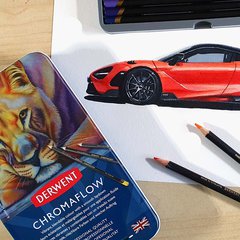
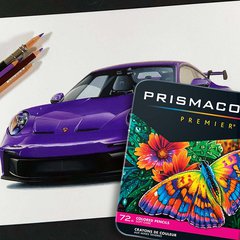

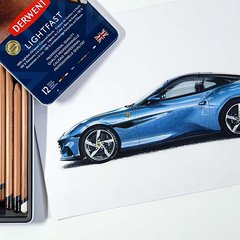
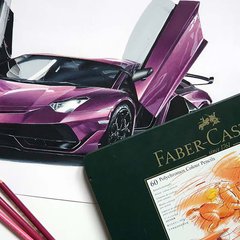
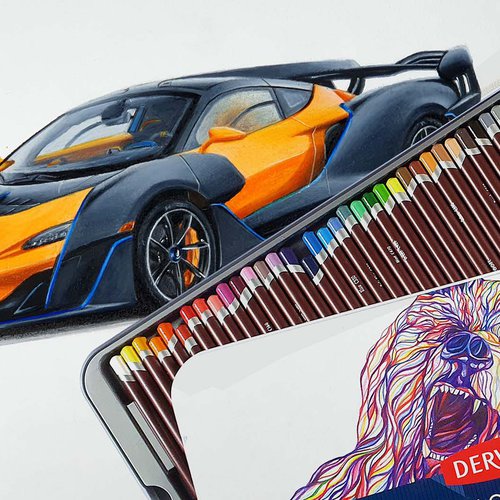
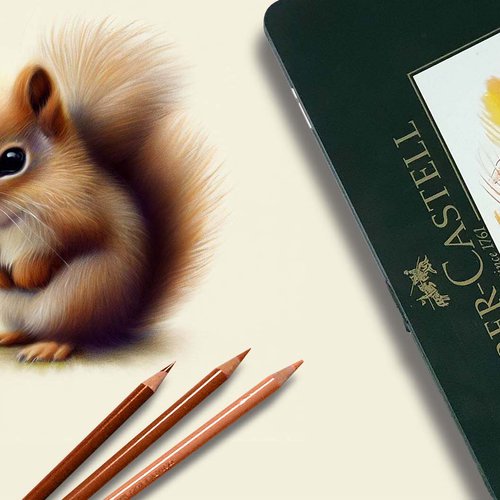
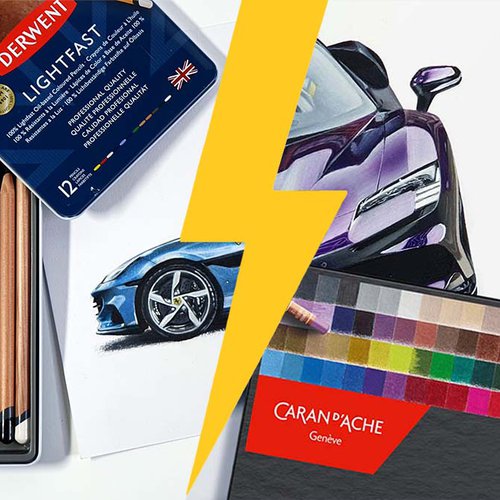
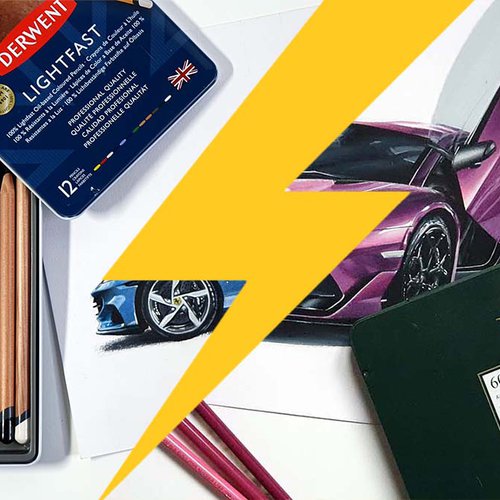
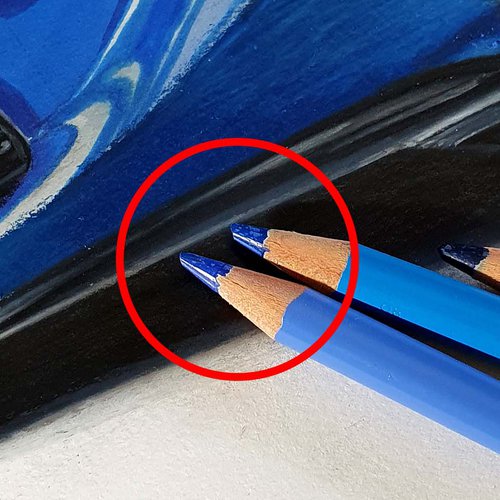
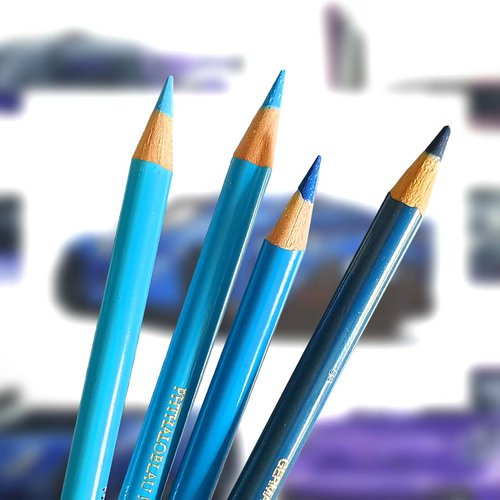

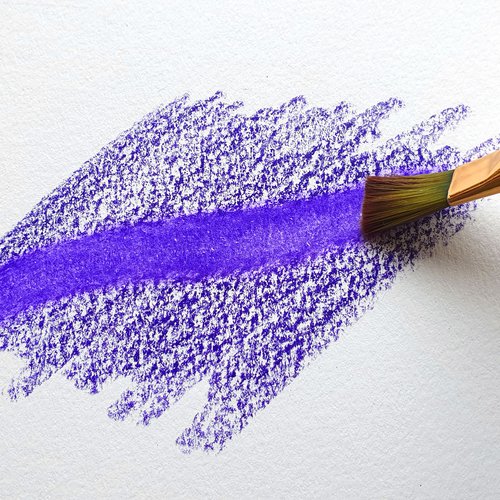
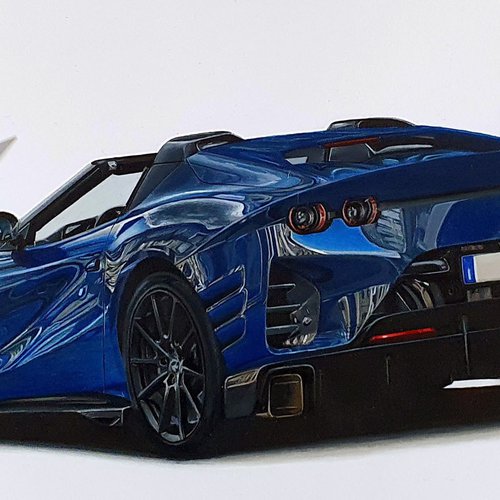




Be the first to comment!
Comments
There are no comments yet.